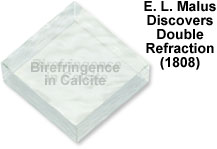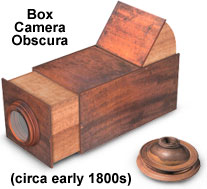1800-1833
In the aftermath of the American and French revolutions, the science of optics experienced its own revolution during the early nineteenth century. Not even a century after the publication of Opticks, English physician and physicist Thomas Young challenged Isaac Newton's corpuscular theory of light. In 1801, Young did an experiment that established the principle of light interference, which could not be explained by a particle theory of light. His experiment allowed light to pass through two closely set pinholes onto a screen where he observed that the beams spread out, or diffracted, and overlapped. In areas where the light beams overlapped, bands of brightness alternated with bands of darkness.

This phenomenon was called interference and Young compared it to waves in water, where the crests of waves meet and combine to make bigger waves or crests and troughs meet and cancel each other out. In 1817, he concluded that they propagate as transverse waves, not longitudinal waves as he originally proposed. Although Young's theory was greeted with a great deal of skepticism in England, two French physicists, Augustin-Jean Fresnel and François Arago, confirmed his wave theory through their own experiments and Fresnel's detailed mathematical analysis.
An accidental discovery in 1808 also provided more evidence for the wave theory. Étienne-Louis Malus, a French engineer, was in his Paris apartment one day toying with a piece of Iceland spar, a crystal known for its property of double refraction; anything viewed through it appeared as two images. Malus was peering through the crystal at an image of the sun that had been reflected from a window across the street. Strangely, the crystal displayed only one image, not the two that Malus was expecting to see. When light reflected off a surface, apparently some of the light was filtered, or polarized. As it turned out, the theory of light as transverse waves explained this phenomenon better than any other theory.
Another accidental discovery hinted at a relationship between electricity and magnetism, and would seriously impact the theory of light several decades later. In 1820, Hans Christian Ørsted noticed that a wire carrying an electric current caused a magnetized compass needle nearby to move, aligning itself perpendicularly to a current-carrying wire. (Although he is credited with discovering this relationship, an Italian, Gian Domenico Romagnosi, had already made the discovery in 1802, but was ignored when he announced his findings.) In 1831, Michael Faraday observed the opposite effect, that a magnet moving through a coil of conductive wire generated an electric current.
Newton's color spectrum went through its own revolution early in the century. In 1802, William Hyde Wollaston discovered seven bands of darkness interrupting what had been presumed to be a continuous range of colors in the solar spectrum. Ten years later, Joseph von Fraunhofer found and measured the positions of over 300 dark lines in the spectrum, establishing the groundwork for a new field of inquiry--spectroscopy.

At about the same time, William Herschel and Johann W. Ritter discovered that there are regions of the spectrum invisible to the human eye. In 1800, Herschel was studying the relationship between light and heat. Using a prism and thermometer with blackened bulbs (for better heat absorption), he measured the temperature of each color of the sun's spectrum. As a control, he measured the temperature just outside the visible spectrum and, to his surprise, found that a region beyond the red portion of the spectrum had the highest temperature. He had discovered an area of the spectrum that could be measured and felt, but not seen--the infrared region.
A year later, Ritter discovered that the other end of the solar spectrum extends beyond the visible. He observed that silver chloride darkened when exposed to visible sunlight, but darkened even more when exposed to invisible radiation beyond the violet end of the spectrum--the ultraviolet region.
|
||||||||||||||||||||||||||||||||||||||||||||
BACK TO TIMELINE IN OPTICS HOME
